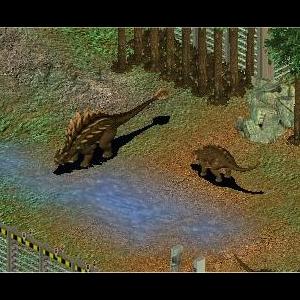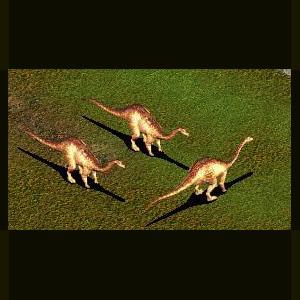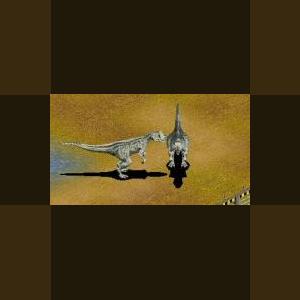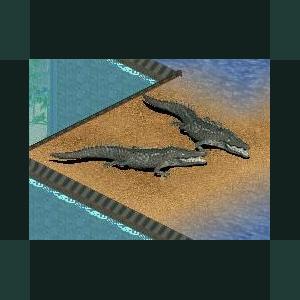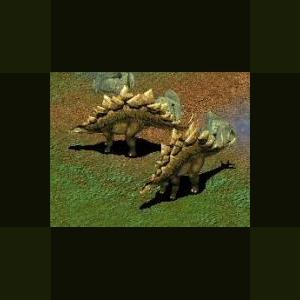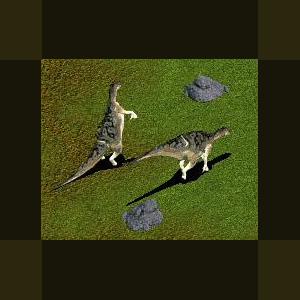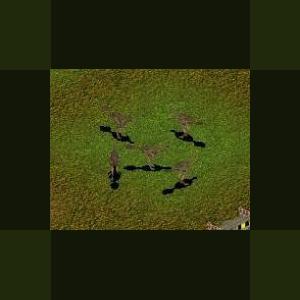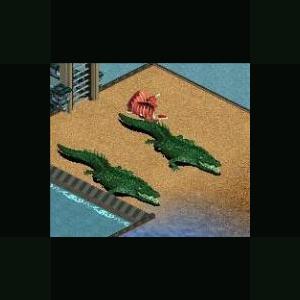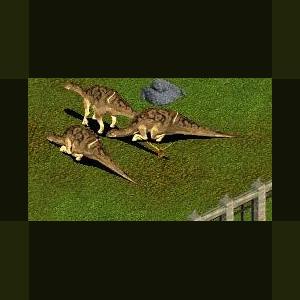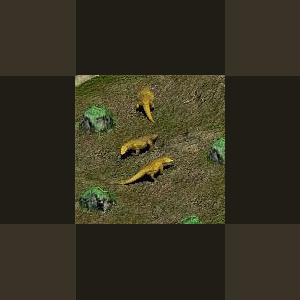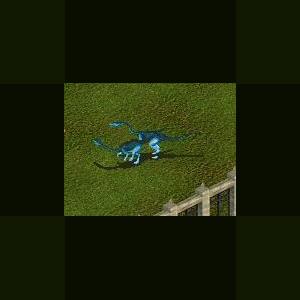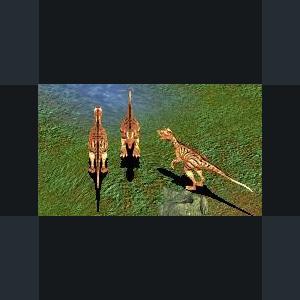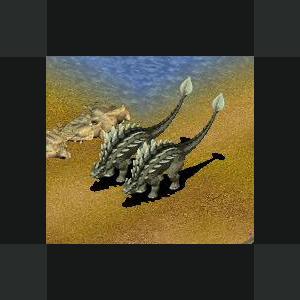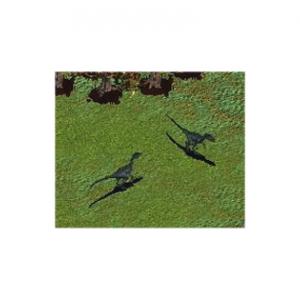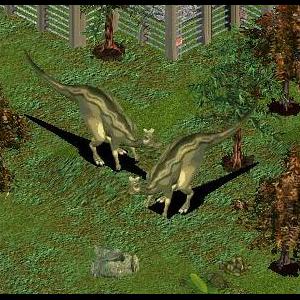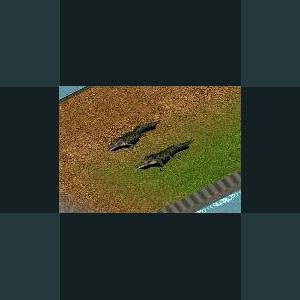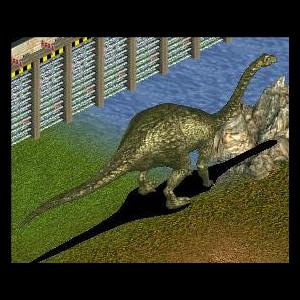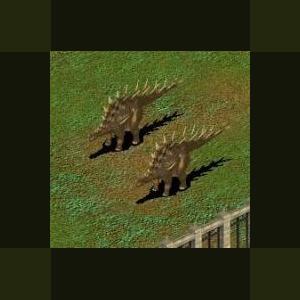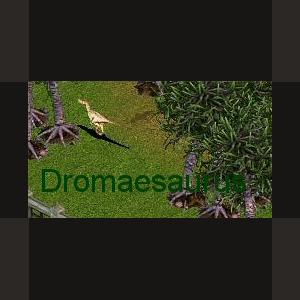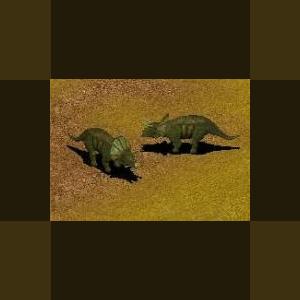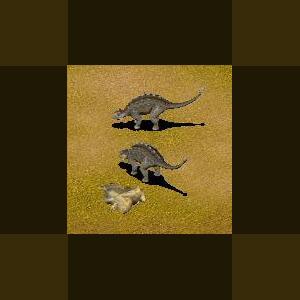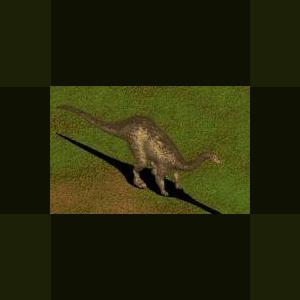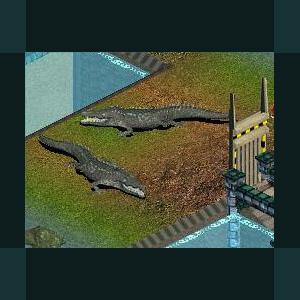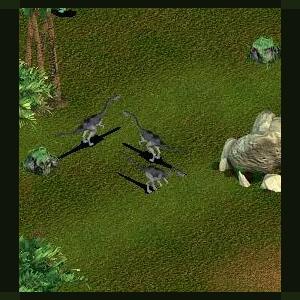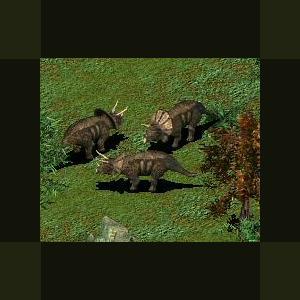Dinosaurs
Creatures from another age
241 files
-
Euplocephalus by Ghirin
By Guest
Euplocephalus ("Well Armored Head") was a large ankylosaur from the Cretaceous period of North America.
It is one of the best known genera of this dinosaur group, with 40 known specimens.
Reference:
The Illustrated Encylopedia of Dinosaurs by Dougal Dixon. 2006
www.wikipedia.com
*Inspired by the Zoo Tycoon Brains Trust at the Zoo Tek Evolved Forums
225 downloads
0 comments
Updated
-
Blikanasaurus by Moondawg
By Guest
Blikanasaurus
Blikanasaurus (meaning "Blikana lizard") was a genus of sauropodomorph dinosaur found in Lower Elliot Formation rocks from the Late Triassic in what is now South Africa's Cape Province. Known from a left lower limb only, it has been variously classified as a prosauropod or basal sauropod. The type species, Blikanasaurus cromptoni, was first described by Galton and van Heerden in 1985
225 downloads
0 comments
Updated
-
Deltadromeus by Moondawg
By Guest
Deltadromeus ("delta runner") is a genus of theropod dinosaur from Northern Africa. This carnivore had long, unusually slender hind limbs for its size, suggesting that it was a swift runner.
It lived in the late Cretaceous Period, about 95 million years ago. It may have been one of the longest carnivorous dinosaurs, with one unpublished survey indicating that a referred partial specimen could represent an individual that was around 13.3 meters (44 ft) long, though it would have weighed only an estimated 3.5 tons, making it more slender than the giant carnosaurs. The more complete holotype specimen measured an estimated 8.1 m (26.5 ft) long. Deltadromeus skeletons have been found with those of the carnosaur Carcharodontosaurus, and it may have lived along side the even larger Spinosaurus. The specific name D. agilis, meaning "swift delta runner", comes from the fact that this species had adaptations for running, and that its remains were found in a fossilized river delta. Deltadromeus was originally described as a large coelurosaur, but more recent studies suggest it was actually a ceratosaur, possibly a gigantic member of the noasaurid family.
220 downloads
0 comments
Updated
-
Mourasuchus by Moondawg
By Guest
Mourasuchus is an extinct genus of giant crocodilian from the Miocene of South America.
219 downloads
0 comments
Updated
-
Wuerhosaurus by Moondawg
By Guest
Wuerhosaurus was a Chinese stegosaur from Early Cretaceous period. It was roughly 7 metres long.
Wuerhosaurus homheni is the type species, described by Dong Zhiming in 1973 from the Tugulu Group in Xinjiang, western China. A smaller species from the Ejinhoro Formation in the Ordos Basin in Inner Mongolia, W. ordosensis, was formalized by the same researcher in 1993.
It was lower to the ground than most other stegosaurids; scientists believe that this was an adaptation to let it feed on low-growing vegetation. Unlike Stegosaurus, Wuerhosaurus had shorter, rounded plates, whose purpose is debated. Wuerhosaurus, like other stegosaurids, had a thagomizer on the end of its tail, which featured four bony spikes that would most likely have been used for self-defense.
Inspired by the Zoo Tek Brains Trust
219 downloads
0 comments
Updated
-
Gyposaurus by Moondawg
By Guest
Gryposaurus is similar to Kritosaurus, and for many years was regarded as the same genus. It is known from numerous skulls, some skeletons, and even some skin impressions that show it to have had pyramidal scales pointing out along the midline of the back. It is most easily distinguished from other duckbills by its narrow arching nasal hump, sometimes described as similar to a "Roman nose," and which may have been used for species or sexual identification, and/or combat with individuals of the same species. A large bipedal/quadrupedal herbivore around 9 meters long (30 ft), it may have preferred river settings.
Gryposaurus was a hadrosaurid of typical size and shape; one of the best specimens, the nearly complete type specimen of G. incurvimanus now on display at the Royal Tyrrell Museum of Palaeontology, came from an animal about 8.2 meters long (27 feet). This specimen also has the best example of skin impressions for Gryposaurus, showing this dinosaur to have had several different types of scalation: pyramidal, ridged, limpet-shaped scutes upwards of 3.8 centimeters long (1.5 inches) on the flank and tail; uniform polygonal scales on the neck and sides of the body; and pyramidal structures, flattened side-to-side, with fluted sides, longer than tall and found along the top of the back in a single midline row.
The four named species of Gryposaurus differ in details of the skull and lower jaw.The prominent nasal arch found in this genus is formed from the paired nasal bones. In profile view, they rise into a rounded hump in front of the eyes, reaching a height as tall as the highest point of the back of the skull. The skeleton is known in great detail, making it a useful point of reference for other duckbill skeletons.
218 downloads
0 comments
Updated
-
Beipiaosaurus by Moondawg
By Guest
Beipiaosaurus is a genus of therizinosauroid theropod dinosaur.
The discovery of Beipiaosaurus , which translates as "Beipiao lizard" after a city in China near the location of its discovery, was announced in the May 27, 1999, issue of the journal Nature. These fossils were found in Liaoning Province, China and have been dated to the early Cretaceous Period, about 125 million years ago. It is known from a single species, B. inexpectus, named for "the surprising features in this animal.". A significant number of fossilized bones for this species were recovered, including: cranial fragments, a mandible, three cervical vertebrae, four dorsal vertebrae, a caudal vertebra, the scapula and scapulacoracoid, a complete forelimb, and a complete pelvis with hindlimb.
The exact classification of therizinosaurs had in the past been hotly debated, since their prosauropod-like teeth and body structure indicate that they were generally herbivorous, unlike typical theropods. Beipiaosaurus, being considered to be a primitive therizinosauroid, has features which suggest that all therizinosauroids, including the more derived Therizinosauridae, to be coelurosaurian theropods, not sauropodomorph or ornithischian relatives as once believed.
Beipiaosaurus measured 2.2 meters (7.3 ft) in length and .88 meters (2.9 ft.) tall at the hip, and is among the largest known feathered dinosaurs. Its weight is estimated as about 85 kg (187 lb.) Beipiaosaurus had a toothless beak with cheek teeth. More advanced therizinosaurids have four functional toes, but the feet of Beipiaosaurus' have reduced inner toes, showing that the derived therizinosaurid condition may have evolved from a three-toed therizinosauroid ancestor. The head was large relative to other therizinosaurs, and it had some features similar to the related oviraptorosaurs. The fossil's skin impressions indicate its body was covered by downy feather-like fibers, which are similar to those of Sinosauropteryx, but longer, and are oriented perpendicular to the arm. Xu et al. suggest that the feathers of Beipiaosaurus represent an intermediate stage between Sinosauropteryx and more advanced birds (Avialae). As only theropod dinosaurs are so far known to have been feathered, this discovery is further evidence that therizinosaurs were indeed theropods.
215 downloads
0 comments
Updated
-
Rhamphosuchus by Moondawg
By Guest
Rhamphosuchus ("Beak crocodile") is an extinct relative of the modern gharial and false gharial.
It inhabited what is now the Indian sub-continent in the Miocene and Pliocene eras. It is only known from incomplete sets of fossils, mostly teeth and skulls, but palaeontologists estimate that it was one of the largest, if not the largest crocodylian that ever lived, reaching an estimated length of 15 to 18 m (50-60 ft). Another crocodylian, Purussaurus from the same era but living in Brazil is estimated to be of similar size from an equally incomplete fossil set. The only other crocodylians which even come close are the Late Cretaceous Deinosuchus and Early Cretaceous Sarcosuchus and also the strange planctivorous Mourasuchus which lived at the same time and in the same region with Purussaurus. As a relation to the modern gharial, Rhamphosuchus almost certainly ate fish, but whether of not it was capable of killing larger animals is unknown.
213 downloads
0 comments
Updated
-
Kritosaurus by Moondawg
By Guest
Kritosaurus (meaning "separated lizard"; sometimes misinterpreted as "noble lizard", in reference to the presumed "Roman nose";
the nasal region was fragmented, disarticulated, and originally restored flat) is an incompletely known but historically important genus of hadrosaurid (duckbilled) dinosaur. It lived about 73 million years ago, in the Late Cretaceous of North and possibly South America. Its taxonomic history is convoluted, also incorporating Gryposaurus, Anasazisaurus, and Naashoibitosaurus; this tangle will remain unresolved until better remains of Kritosaurus are described. Despite the dearth of material, this herbivore appeared in dinosaur books until the 1990s, although what was usually represented was the much more completely known Gryposaurus, then thought to be a synonym.
Kritosaurus is only definitely determined from a partial skull and lower jaws, and associated undescribed postcranial remains. The greater portion of the muzzle and upper beak are missing, but additional reconstruction in the early 2000s using fragments from the skull that had not been placed before show part of a crest in front of the eyes; the form of the crest is unknown at this point. The length of the skull is estimated at 87 centimeters (34 in) from the tip of the upper beak to the base of the quadrate that articulates with the lower jaw at the back of the skull.
Potential diagnostic characteristics of Kritosaurus include a predentary (lower beak) without tooth-like crenulations,
a sharp downward bend to the lower jaws near the beak, and a heavy, somewhat rectangular maxilla (upper tooth-bearing bone). If it turns out to be the same as Anasazisaurus or Naashoibitosaurus, then the form of the complete crest is that of a tab or flange beginning in front of the eyes and rising between and above them, but not extended beyond them.
212 downloads
0 comments
Updated
-
Sphagesaurus by Moondawg
By Guest
Sphagesaurus
The type species S. huenei, was discovered in 1950 by Price, with the both the genus and species named from an isolated tooth. More recently a nearly complete skull of S. huenei was described and published, helping to elucidate the evolutionary relationships of Sphagesaurus with other notosuchians. A second species, S. montealtensis has also been described from the Late Cretaceous of Brazil
208 downloads
0 comments
Updated
-
Borogovia by Moondawg
By Guest
Borogovia was a theropod dinosaur which lived during the Late Cretaceous Period, in what is now Mongolia.
The agile carnivorous troodontid takes its name from creatures known as 'borogoves' in the Lewis Carroll poem, Jabberwocky.
Known only by partial hind limbs, the Borogovia was 2 meters (6 feet) long and weighed 13 kilograms (27 pounds).
207 downloads
0 comments
Updated
-
Proceratosaurus by Moondawg
By Guest
Proceratosaurus is a genus of medium-sized carnivorous theropod dinosaur from the Middle Jurassic of England.
Originally thought to be an ancestor of Ceratosaurus due to the similar small crest on its snout, it is now considered a coelurosaur, one of the earliest known. Proceratosaurus may have been related to the ancestors of later forms such as Ornitholestes and the tyrannosaurs.
207 downloads
0 comments
Updated
-
Cedarpelta by Moondawg
By Guest
Cedarpelta is the most basal known ankylosaurid ankylosaur (Ankylosauridae; Ankylosauria), based on material recovered from the Lower Cretaceous of North America.
The skull lacks extensive cranial ornamentation, a trait which has been interpreted as plesiomorphic for ankylosaurs. Carpenter et al. (2001) diagnose Cedarpelta by the presence of a rostrocaudally elongate pterygoid with a caudolaterally oriented, trochlear-like process, a premaxilla with six conical teeth, and a straight ischium. The presence of premaxillary teeth is a plesiomorphic character because it is present in other, primitive ornithischians. In contrast, closure of the opening on the side of the skull behind the orbit, the lateral temporal fenestra, is an advanced (apomorphic) character only known in ankylosaurid ankylosaurs.
Two skulls are known, and the skull length for Cedarpelta is estimated to have been roughly 60 cm. Significantly, one of the Cedarpelta skulls was found disarticulated, a first for an ankylosaur skull, allowing paleontologists a unique opportunity to examine the individual bones instead of being limited to a cossified unit. The etymology of this binomen may be read as "Bilbey and Hall's Cedar (Mountain) shield," with the genus named for the Cedar Mountain Formation and the animal's armored plates and the species named for Sue Ann Bilbey and Evan Hall, discoverers of the type locality.
All material referrable to Cedarpelta has been recovered from the Ruby Ranch Member of the Cedar Mountain Formation. Radiometric dates place the site the specimen was collected in the (Albian) of eastern Utah.
206 downloads
0 comments
Updated
-
Ebony Velociraptor by Ghirin
By Guest
Ebony Velociraptor
Author: Ghirin
http://www.zoo-tek.com/forums/index.php?download=109
The ebony velociraptor is a melanistic variant of the velociraptor. In melanism, the high production of melanin leads to dark brown or black fur and/or skin. Melanistic variants are found in many different species ranging from fish to mammals and in some cases this color variant does not pose a major handicap to the individual (unlike albinism and leucism).
Melanistic animals tend to have higher survival rates in areas of dense foliage, where the darker pigment might provide better camouflage. This appears to be the case in felines such as black leopards and jaguars. In other instances, such as animals living in open country with little plant cover would be at a disadvantage because they would be more conspicuous to prey or predators.
Like modern animals, melanistic individuals occurred in dinosaur populations. Predators that lived in forested areas probably had
References:
Designer Reptiles and Amphibians. R.D. Bartlett and Patricia Bartlett, 2001.
Reptile and Amphibian Variants: Colors, Patterns, and Scales. H. Bernard Bechtel, 1995.
The Corn Snake Manual. Bill Love and Kathy Love, 2000.
Walker's Mammals of World. Nowak, 1999.
Created by Ghirin
204 downloads
Updated
-
Hypacrosaurus by Moondawg
By Guest
Hypacrosaurus
Hypacrosaurus (meaning "near the highest lizard", because it was almost but not quite as large as Tyrannosaurus) was a genus of duckbill dinosaur similar in appearance to Corythosaurus. Like Corythosaurus, it had a tall, hollow rounded crest, although not as large and straight. It is known from the remains of two species that lived about 76 to 68 million years ago, in the Late Cretaceous of Alberta, Canada, and Montana, USA, and is the latest hollow-crested duckbill known from good remains in North America. It was an obscure genus until the description of nests, eggs, and hatchlings belonging to H. stebingeri in the 1990s.
Hypacrosaurus is most easily distinguished from other hollow-crested duckbills (lambeosaurines) by its tall neural spines and the form of its crest. The neural spines, which project from the top of the vertebrae, are 5 to 7 times the height of the body of their respective vertebrae in the back, which would have given it a tall back in profile. The skull's hollow crest is like that of Corythosaurus, but is more pointed along its top, not as tall, wider side to side, and has a small bony point at the rear. Unlike other lambeosaurines, the passages for the airways do not form an S-curve in the crest (at least not in H. altispinus). The animal is estimated to have been around 9.1 meters long (30 feet), and to have weighed up to 4.0 tonnes (4.4 tons). As with most duckbills, its skeleton is otherwise not particularly remarkable, although some pelvic details are distinctive. Like other duckbills, it was a bipedal/quadrupedal herbivore. The two known species, H. altispinus and H. stebingeri, are not differentiated in the typical method, of unique characteristics, as H. stebingeri was described as transitional between the earlier Lambeosaurus and later Hypacrosaurus. Photographs of an adult H. stebingeri skull show an animal that looks very similar to H. altispinus.
Hypacrosaurus was a lambeosaurinae hadrosaurid, and has been recognized as such since the description of its skull. Within the Lambeosaurinae, it is closest to Lambeosaurus and Corythosaurus, with Jack Horner and Phil Currie (1994) suggesting that H. stebingeri is transitional between Lambeosaurus and H. altispinus, and Michael K. Brett-Surman (1989) suggesting that Hypacrosaurus and Corythosaurus are the same genus. These genera, particularly Corythosaurus and Hypacrosaurus, are regarded as the "helmeted" or "hooded" branch of the lambeosaurines, and the clade they form is sometimes informally designated Lambeosaurini. Although Suzuki et al.'s 2004 redescription of Nipponosaurus found a close relationship between Nipponosaurus and Hypacrosaurus stebingeri, indicating that Hypacrosaurus may be paraphyletic, this was rejected in a later, more comprehensive reanalysis of lambeosaurines, which found the two species of Hypacrosaurus to form a clade without Nipponosaurus, with Corythosaurus and Olorotitan being the closest relatives.
The type remains of Hypacrosaurus remains were collected in 1910 by Barnum Brown for the American Museum of Natural History. The remains, a partial postcranial skeleton consisting of several vertebrae and a partial pelvis (AMNH 5204), came from along the Red Deer River near Tolman Ferry, Alberta, Canada, from rocks of what is now known as the Horseshoe Canyon Formation (early Maastrichtian, Upper Cretaceous). Brown described these remains, in combination with other postcranial bones, in 1913 as a new genus that he considered to be like Saurolophus. No skull was known at this time, but two skulls were soon discovered and described.
During this period, the remains of small hollow-crested duckbills were described as their own genera and species. The first of these that figure into the history of Hypacrosaurus was Cheneosaurus tolmanensis, based on a skull and assorted limb bones, vertebrae, and pelvic bones from the Horseshoe Canyon Formation. Not long after, Richard Swann Lull and Nelda Wright identified an American Museum of Natural History skeleton (AMNH 5461) from the Two Medicine Formation of Montana as a specimen of Procheneosaurus. These and other taxa were accepted as valid genera until the 1970s, when Peter Dodson showed that it was more likely that the "cheneosaurs" were the juveniles of other established lambeosaurines. Although he was mostly concerned with the earlier, Dinosaur Park Formation genera Corythosaurus and Lambeosaurus, he suggested that Cheneosaurus would turn out to be composed of juvenile individuals of the contemporaneous Hypacrosaurus altispinus. This idea has become accepted, although not formally tested. The Two Medicine Procheneosaurus, meanwhile, was not quite like the other Procheneosaurus specimens studied by Dodson, and for good reason: it was much more like a species that would not be named until 1994, H. stebingeri.
H. altispinus shared the Horseshoe Canyon Formation with fellow hadrosaurids Edmontosaurus and Saurolophus, hypsilophodont Parksosaurus, ankylosaurid Euoplocephalus, nodosaurid Edmontonia, horned dinosaurs Montanoceratops, Anchiceratops, Arrhinoceratops, and Pachyrhinosaurus, pachycephalosaurid Stegoceras, ostrich-mimics Ornithomimus and Struthiomimus, a variety of poorly-known small theropods including troodontids and dromaeosaurids, and the tyrannosaurs Albertosaurus and Daspletosaurus. The dinosaurs from this formation are sometimes known as Edmontonian, after a land mammal age, and are distinct from those in the formations above and below. The Horseshoe Canyon Formation is interpreted as having a significant marine influence, due to an encroaching Western Interior Seaway, the shallow sea that covered the midsection of North America through much of the Cretaceous. H. altispinus may have preferred to stay more landward.
The slightly older Two Medicine Formation, home to H. stebingeri, was also populated by another well-known nesting hadrosaur, Maiasaura, as well as the troodontid Troodon, which is also known from nesting traces. The tyrannosaurid Daspletosaurus, caenagnathid Chirostenotes, dromaeosaurids Bambiraptor and Saurornitholestes, armored dinosaurs Edmontonia and Euoplocephalus, hypsilophodont Orodromeus, hadrosaur Prosaurolophus, and horned dinosaurs Achelousaurus, Brachyceratops, Einiosaurus, and Styracosaurus ovatus were also present. This formation was more distant from the Western Interior Seaway, higher and drier, with a more terrestrial influence.
As a hadrosaurid, Hypacrosaurus would have been a bipedal/quadrupedal herbivore, eating a variety of plants. Its skull permitted a grinding motion analogous to chewing, and its teeth were continually replacing and packed into dental batteries that contained hundreds of teeth, only a relative handful of which were in use at any time. Plant material would have been cropped by its broad beak, and held in the jaws by a cheek-like organ. Its feeding range would have extended from the ground to ~4 m (13 ft) above.
H. stebingeri laid roughly spherical eggs of 20 by 18.5 cm (7.9 by 7.3 inches), with embryos 60 cm long (23.6 in). Hatchlings were around 1.7 m long (5.6 ft). Young and embryonic individuals had deep skulls with only slight expansion in the bones that would one day form the crest. Growth was faster than that of an alligator and comparable to ratite growth, for several years, based on the amount of bone growth seen between lines of arrested growth (analogous to growth rings in trees). Research by Lisa Cooper and colleagues on H. stebingeri indicates that this animal may have reached reproductive maturity at the age of 2 to 3 years, and reached full size at about 10 to 12 years old. The circumference of the thigh bone at postulated reproductive maturity was about 40% that of its circumference at full size. The postulated growth rate of H. stebingeri outpaces those of tyrannosaurids (predators of hypacrosaurs) such as Albertosaurus and Tyrannosaurus; rapidly-growing hypacrosaurs would have had a better chance to reach a size large enough to be of defensive value, and beginning reproduction at an early age would also have been advantageous to a prey animal.
The hollow crest of Hypacrosaurus most likely had social functions, such as a visual signal allowing individuals to identify sex or species, and providing a resonating chamber for making noises. The crest and its associated nasal passages have also figured in the debate about dinosaur endothermy, specifically in discussions about nasal turbinates.
Turbinates are thin bones or cartilages that come in two types, with two functions. Nasal olfactory turbinates are found in all living tetrapods and function in smell. Respiratory turbinates function to prevent water loss through evaporation and are found only in birds and mammals, modern endotherms (warm-blooded animals) who could lose a great deal of water while breathing because they breathe more often than comparably-sized ectotherms (cold-blooded animals) to support their higher metabolism. Ruben and others in 1996 concluded that respiratory turbinates were probably not present in Nanotyrannus, Ornithomimus or Hypacrosaurus based on CT scanning, thus there was no evidence that those animals were warm-blooded.
204 downloads
0 comments
Updated
-
Rutiodon by Moondawg
By Guest
Rutiodon
Rutiodon is an extinct genus of archosaurian reptile belonging to the phytosaur (plant lizard) group of the Triassic era. It was up to 3 m long.
Like other phytosaurs, Rutiodon strongly resembled a crocodile, with the only exception being the fact that its nostrils were positioned close to the eyes. Because of its enlarged front teeth, it most closely resembled the gharial. It probably caught fish and also snatched land animals from the waterside.It was an ambush predator. The animal is known from fossils in Europe (Germany and Switzerland as well as North America (Arizona, New Mexico, North Carolina, Texas). Its tail was covered with armour.
204 downloads
0 comments
Updated
-
Supersaurus by Moondawg
By Guest
Supersaurus (meaning "super lizard") is a genus of diplodocid sauropod dinosaur discovered in the Upper Jurassic Morrison Formation of Colorado in 1972.
It is among the largest dinosaurs known from good remains, possibly reaching 33 to 34 meters (108 to 112 ft) in length, and a weight of 35 to 40 tons.
The original fossil remains of Supersaurus yielded only a few bones: the shoulder girdle (type specimen BYU 5500) and a few neck vertebrae. This shoulder girdle (or scapulocoracoid) stood some 2.4 meters (8 ft) tall, if placed on end.
A new and much more complete specimen of Supersaurus, nicknamed 'Jimbo', has been found in Converse County, Wyoming. It is currently being excavated and its bones are being held at the Wyoming Dinosaur Center. Originally, it was thought that Supersaurus was related to the long-necked diplodocid Barosaurus (a member of the subfamily Diplodocinae), but the new specimen makes it clear that Supersaurus is actually more closely related to Apatosaurus (a member of the subfamily Apatosaurinae).
202 downloads
0 comments
Updated
-
Chungkingosaurus by Moondawg
By Guest
Chungkingosaurus, meaning "Chongqing Lizard", was a genus of dinosaur from the Late Jurassic from the Upper Shaximiao Formation in what is now China. It is classified as a Stegosaurid.
The type species, Chungkingosaurus jiangbeiensis, was found near Chongqing, China. in 1977 and described by Dong Zhiming, Zhou Shiwu, and Chang Yihong in 1983. There were many stegosaurs found in China in 1977 (the year Chungkingosaurus was found), but Chungkingosaurus was the smallest of these.
One of the smallest of the family at 3-4 metres long (10-13 ft), Chungkingosaurus had at least five spikes on its thagomizer. It had a rather high and narrow skull and large, thick bony plates. Like all stegosaurs, it was a herbivore. Chungkingosaurus had spiny plates on its back, which were arranged in pairs, but the total number is unknown. A specimen in the Chongqing Municipal museum is represented as having 14 pairs of plates. This specimen also had two pairs of tail spikes.
Chungkingosaurus is thought to have coexisted with large plant-eaters and stegosaurids such as Chialingosaurus, Tuojiangosaurus, Mamenchisaurus, and Omeisaurus. It may have also faced being a meal of predators such as the theropods Yangchuanosaurus and Szechuanosaurus.
201 downloads
0 comments
Updated
-
Dromaeosaurus by Moondawg
By Guest
The first known Dromaeosaurus remains were first discovered by paleontologist Barnum Brown during a 1914 expedition to the Judith River Formation on behalf of the American Museum of Natural history. The area where these bones were collected is now part of Dinosaur Provincial Park in Alberta, Canada. The find consisted of a partial skull 9 inches in length and some foot bones. Several other bones, and dozens of isolated teeth, are also known from subsequent discoveries in Alberta and the western United States.[1]
Several species of Dromaeosaurus have been described, but Dromaeosaurus albertensis is the most complete specimen. Additionally, it is apparent that this genus is even rarer than other small theropods, although it was one of the first small theropods described based on reasonably good cranial material.
In 1969 similarities in anatomy between Dromaeosaurus and its relative Deinonychus were first observed. Based on the sickle-claws and commonalities in the skull, a new family, the dromaeosauridae was erected to house these two genera.[1] Since then, many new relatives of Dromaeosaurus have been found.
Dromaeosaurus differs from most other Dromaeosauridae in having a short, massive skull, a deep mandible, and robust teeth. In these respects Dromaeosaurus resembled the tyrannosaurs. The teeth tend to be more heavily worn than those of its relative Saurornitholestes, suggesting that its jaws were used for crushing and tearing rather than simply slicing through flesh.
It is possible that Dromaeosaurus was more of a scavenger than other small theropods, or it may be that Dromaeosaurus relied more heavily on its jaws to dispatch its prey. It was probably better suited to tackling large prey than the more lightly built Saurornitholestes.
The relationships of Dromaeosaurus are unclear. Although its rugged build gives it a primitive appearance, it was actually a very specialized animal. It is usually given its own subfamily, the Dromaeosaurinae; this group is thought to include Utahraptor, Achillobator, Adasaurus and perhaps Deinonychus.
However, the relationships of dromaeosaurs are still in a state of flux. "Dromaeosaurus Morphotype A" is the designation given to a series of unusual, ridged dromaeosaur teeth from Alberta. These teeth probably do not belong to Dromaeosaurus, although it is unclear from what animal they do come.
201 downloads
0 comments
Updated
-
Diceratus by Moondawg
By Guest
Diceratus (meaning "two-horned") is a ceratopsid herbivorous dinosaur genus from the Late Cretaceous period of North America. It is known only from a single poorly preserved skull discovered in Wyoming and described in 1905 as Diceratops.
For many years, it had been considered a species within the genus Triceratops, but recent analysis (Forster, 1996) suggests it is a distinct genus. Since the Diceratops name was preoccupied, it was renamed to Diceratus in 2008.
Diceratus was first described as Diceratops ("two horned face"), but it was found that the name was already in use for a hymenopteran (Foerster, 1868). It was given its current name by Octávio Mateus in 2008.
The paper that described Diceratus was originally part of O. C. Marsh's magnum opus, his Ceratopsidae monograph. Unfortunately, Marsh died (1899) before the work was completed, and John Bell Hatcher endeavored to complete the Triceratops section. However, he died of typhus in 1904 at the age of 42, leaving the paper still uncompleted. It fell to Richard Swann Lull to complete the monograph in 1905, publishing Hatcher's description of a skull separately and giving it the name Diceratops hatcheri.
Since the Diceratops paper had been written by Hatcher, and Lull had only contributed the name and published the paper after Hatcher's death, Lull was not quite as convinced of the distinctiveness of Diceratops, thinking it primarily pathological. By 1933, Lull had had second thoughts about Diceratops being a distinct genus and he put it in a subgenus of Triceratops: Triceratops (Diceratops), including T. obtusus; largely attributing its differences to being that of an aged individual.
200 downloads
0 comments
Updated
-
Gargoyleosaurus by Moondawg
By Guest
Gargoyleosaurus parkpinorum ("gargoyle lizard") is both the smallest and the earliest known ankylosaur.
Its skull measures only 29 cm in length, and its total body length is an estimated three to four meters. It may have weighed as much as a tonne. The holotype was discovered at the Bone Cabin Quarry West locality, in Albany County, Wyoming in exposures of the Upper Jurassic (Kimmeridgian to Tithonian stages) Morrison Formation.
The next earliest known ankylosaur is Minmi paravertebrata from the Aptian stage in Queensland, Australia. The type species, G. parkpinorum (originally G. parkpini) was described by Ken Carpenter et al. in 1998. A mounted skeletal reconstruction of Gargoyleosaurus parkpinorum can be seen at the Denver Museum of Nature and Science.
The holotype specimen of Gargoyleosaurus parkpinorum was collected by Western Paleontology Labs in 1996 and is currently held in the collections of the Denver Museum of Nature and Science, Denver, Colorado. Besides the holotype, two other partial skeletons are known (although not yet described) The holotype consists of most of the skull and a partial postcranial skeleton. The specimen was originally described as Gargoyleosaurus parkpini by Carpenter, Miles and Cloward in 1998, then renamed G. parkpinorum by Carpenter et al. in 2001, in accordance with ICZN art. 31.1.2A.
Much of the skull and skeleton has been recovered, and the taxon displays cranial sculpturing, including pronounced deltoid quadratojugal and squamosal bosses. The taxon is further characterized by a narrow rostrum (in dorsal view), the presence of seven conical teeth in each premaxilla, an incomplete osseous nasal septum, a linerarly arranged nasal cavity, the absence of an osseus secondary palate, and, as regards osteoderms, two sets of co-ossified cervical plates and a number of elongate conical spines.
199 downloads
0 comments
Updated
-
Austrosaurus by Moondawg
By Guest
Austrosaurus (meaning "Southern lizard") was a sauropod dinosaur from the Winton Formation, from the early Cretaceous (98-95 Million Years ago) of Central-Western Queensland in Australia.
The remains were discovered by Mr. H.B. Wade on Clutha Station near Maxwelton in north Queensland in 1932, who alerted the station manager H. Mackillop, who showed his brother who sent them to the Queensland Museum. Austrosaurus was described by Heber Longman in 1933.
In 1999 on a property near Winton in central-western Queensland, Australia, grazier Dave Elliott found a sauropod femur belonging to what turned out to be the largest dinosaur discovered in Australia to that date, which was nicknamed 'Elliot'. At the Winton find, a right femur and portions of several ribs have so far been uncovered. A smaller sauropod, nicknamed 'Mary', after Dr Mary Wade, has also been uncovered. Early indications are that they are closely related to Austrosaurus mackillopi and either in the same or closely related genus.
On 3 May 2007, bones from the remains of two huge titanosaurs which were uncovered in 2004 near Eromanga in south-west Queensland went on display at the Queensland Museum, in Brisbane. This find was described by the ABC news service as the largest bones now discovered to date in Australia, eclipsing 'Elliot'.
Originally it was thought that the Austrosaurus had a tendency to spend time near or in water to relieve weight from their legs. However, this theory is now rejected and it is thought that the Austrosaurus preferred hard, dry land. Fossil finds suggest a height of approximately 3.9 metres at the hip and 4.1 metres at the shoulder, which would have given it an almost level back.
Initially, Austrosaurus was considered a cetiosaurid, like Patagosaurus or Shunosaurus. However, a recent reappraisal of material by Ralph Molnar has found that it, and the newer remains of 'Eliot', are titanosaurid, as various features on the vertebrae show.
198 downloads
0 comments
Updated
-
Smilosuchus by Moondawg
By Guest
Smilosuchus
Smilosuchus is an extinct genus of phytosaur from the Late Triassic of North America.
The crurotarsans were a fabulous bunch of monsters. Some called phytosaurs looked and lived a lot like today's crocodiles, staying submerged in rivers or lakes until attacking a victim. The North American phytosaur Smilosuchus grew to 39 feet long.
This is probably the biggest Phytosaur known,with a length up to 12m (40 ft)rivaling some of the biggest crocodiles that ever existed.It was probably the largest land animalof the late Triassic.Usually the largest land animals are plant-eaters.In Triassic times they were meat-eaters.
198 downloads
0 comments
Updated
-
Ornitholestes by Moondawg
By Guest
Ornitholestes
Ornitholestes ("bird robber") was a small theropod dinosaur of the late Jurassic of Western Laurasia (the area that was to become North America). Almost everything known of this species comes from a single skeleton of Ornitholestes, found near Como Bluff in 1900, and described by Henry Fairfield Osborn in 1903. A hand was later attributed to Ornitholestes, although this attribution is now in doubt. The species name honours the AMNH preparator Adam Hermann.
Ornitholestes was roughly 2 meters (6.5 ft) in length. The head of Ornitholestes was relatively small. Nonetheless, the skull was more robust than that of many other small theropods, such as Compsognathus and Coelophysis, and this would have enabled Ornitholestes to deliver a powerful bite.
Gregory S. Paul suggested the presence of a small horn on the snout of Ornitholestes, similar to that of Proceratosaurus. however this has recently been disproved by Carpenter et al., which indicated that the 'crest' was actually a broken nasal bone. Like most other theropods, Ornitholestes had a long tail, presumably used for balance
Ornitholestes was a coelurosaur, similar in many ways to Compsognathus, though somewhat larger.
The sharp teeth of Ornitholestes clearly identify it as a carnivore, but its exact diet has been a subject of debate in the paleontological community.
In his original 1903 description, Henry Fairfield Osborn suggested that Ornitholestes might have preyed on contemporary birds, based on the "rapid grasping power of agile and delicate prey" suggested by the structure of the hand. In 1917, however, Osborn reevaluated the hand and determined that it was unsuitable for this purpose.
More recently, Robert T. Bakker speculated that Ornitholestes probably hunted small mammals, noting that "the Como furballs were just the right size to fit the predator's jaws."
198 downloads
0 comments
Updated
-
Turanoceratops by Moondawg
By Guest
Turanoceratops
Turanoceratops ("Turan horn face") is a genus of ceratopsian dinosaur. Its fossil remains were recovered from the Bissekty Formation of Uzbekistan, dating to the late Cretaceous Period (mid-late Turonian stage) about 90 million years ago. It may be the only member of the family Ceratopsidae known from outside North America, and be among the earliest ceratopsids, though this interpretation has been disputed.
Turanoceratops belonged to the Ceratopsia (the name is Greek for "horned face"), a group of herbivorous dinosaurs with parrot-like beaks which thrived in North America and Asia during the Cretaceous Period, which ended roughly 65 million years ago. All ceratopsians became extinct at the end of this era.
A 2009 study lead by Hans-Dieter Sues analysed additional fossil material of Turanoceratops and concluded that, contrary to expectations, it represented a true (though "transitional") member of the family Ceratopsidae. If correct, it would represent the only Asian ceratopsid, all other species being found in North America.
Some scientists, such as Andrew Farke, disagreed with Sues' findings. Farke and colleagues ran an independent phylogenetic analysis of the new Turanoceratops fossils and found that it was a close relative of Ceratopsidae (the immediate sister group) but was not a true member of that clade. Sues and Alexander Averianov criticised that analysis, arguing that Farke and colleagues misinterpreted or mis-coded some characteristics of the fossil in their analysis.
Turanoceratops, like all ceratopsians, was a herbivore. During the Cretaceous, flowering plants were "geographically limited on the landscape", and so it is likely that this dinosaur fed on the predominant plants of the era: ferns, cycads and conifers. It would have used its sharp ceratopsian beak to bite off the leaves or needles.
197 downloads
0 comments
Updated

